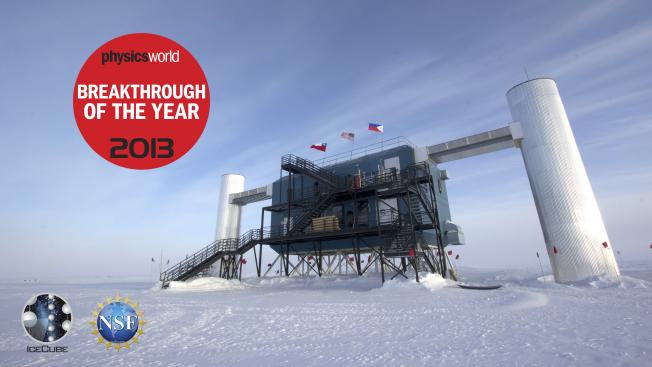Search for Astrophysical Neutrinos from 1FLE Blazars with IceCube
The Astrophysical Journal American Astronomical Society 938:1 (2022) 38
Authors:
R Abbasi, M Ackermann, J Adams, JA Aguilar, M Ahlers, M Ahrens, JM Alameddine, AA Alves, NM Amin, K Andeen, T Anderson, G Anton, C Argüelles, Y Ashida, S Athanasiadou, S Axani, X Bai, A Balagopal V., M Baricevic, SW Barwick, V Basu, R Bay, JJ Beatty, K-H Becker, J Becker Tjus, J Beise, C Bellenghi, S Benda, S BenZvi, D Berley, E Bernardini, DZ Besson, G Binder, D Bindig, E Blaufuss, S Blot, F Bontempo, JY Book, J Borowka, S Böser, O Botner, J Böttcher, E Bourbeau, F Bradascio, J Braun, B Brinson, S Bron, J Brostean-Kaiser, RT Burley, RS Busse, MA Campana, EG Carnie-Bronca, C Chen, Z Chen, D Chirkin, K Choi, BA Clark, L Classen, A Coleman, GH Collin, A Connolly, JM Conrad, P Coppin, P Correa, DF Cowen, R Cross, C Dappen, P Dave, C De Clercq, JJ DeLaunay, D Delgado López, H Dembinski, K Deoskar, A Desai, P Desiati, KD de Vries, G de Wasseige, T DeYoung, A Diaz, JC Díaz-Vélez, M Dittmer, H Dujmovic, MA DuVernois, T Ehrhardt, P Eller, R Engel, H Erpenbeck, J Evans, PA Evenson, KL Fan, AR Fazely, A Fedynitch, N Feigl, S Fiedlschuster, AT Fienberg, C Finley, L Fischer, D Fox, A Franckowiak, E Friedman, A Fritz, P Fürst, TK Gaisser, J Gallagher, E Ganster, A Garcia, S Garrappa, L Gerhardt, A Ghadimi, C Glaser, T Glauch, T Glüsenkamp, N Goehlke, JG Gonzalez, S Goswami, D Grant, T Grégoire, S Griswold, C Günther, P Gutjahr, C Haack, A Hallgren, R Halliday, L Halve, F Halzen, H Hamdaoui, M Ha Minh, K Hanson, J Hardin, AA Harnisch, P Hatch, A Haungs, K Helbing, J Hellrung, F Henningsen, EC Hettinger, L Heuermann, S Hickford, J Hignight, C Hill, GC Hill, KD Hoffman, K Hoshina, W Hou, M Huber, T Huber, K Hultqvist, M Hünnefeld, R Hussain, K Hymon, S In, N Iovine, A Ishihara, M Jansson, GS Japaridze, M Jeong, M Jin, BJP Jones, D Kang, W Kang, X Kang, A Kappes, D Kappesser, L Kardum, T Karg, M Karl, A Karle, U Katz, M Kauer, JL Kelley, A Kheirandish, K Kin, J Kiryluk, SR Klein, A Kochocki, R Koirala, H Kolanoski, T Kontrimas, L Köpke, C Kopper, S Kopper, DJ Koskinen, P Koundal, M Kovacevich, M Kowalski, T Kozynets, E Krupczak, E Kun, N Kurahashi, N Lad, C Lagunas Gualda, MJ Larson, F Lauber, JP Lazar, JW Lee, K Leonard, A Leszczyńska, M Lincetto, QR Liu, M Liubarska, E Lohfink, CJ Lozano Mariscal, L Lu, F Lucarelli, A Ludwig, W Luszczak, Y Lyu, W Y., J Madsen, KBM Mahn, Y Makino, S Mancina, W Marie Sainte, IC Mariş, I Martinez-Soler, R Maruyama, S McCarthy, T McElroy, F McNally, JV Mead, K Meagher, S Mechbal, A Medina, M Meier, S Meighen-Berger, Y Merckx, J Micallef, D Mockler, T Montaruli, RW Moore, R Morse, M Moulai, T Mukherjee, R Naab, R Nagai, U Naumann, J Necker, LV Nguyễn, H Niederhausen, MU Nisa, SC Nowicki, A Obertacke Pollmann, M Oehler, B Oeyen, A Olivas, J Osborn, E O’Sullivan, H Pandya, DV Pankova, N Park, GK Parker, EN Paudel, L Paul, C Pérez de los Heros, L Peters, J Peterson, S Philippen, S Pieper, A Pizzuto, M Plum, Y Popovych, A Porcelli, M Prado Rodriguez, B Pries, GT Przybylski, C Raab, J Rack-Helleis, A Raissi, M Rameez, K Rawlins, IC Rea, Z Rechav, A Rehman, P Reichherzer, G Renzi, E Resconi, S Reusch, W Rhode, M Richman, B Riedel, EJ Roberts, S Robertson, S Rodan, G Roellinghoff, M Rongen, C Rott, T Ruhe, D Ryckbosch, D Rysewyk Cantu, I Safa, J Saffer, D Salazar-Gallegos, P Sampathkumar, SE Sanchez Herrera, A Sandrock, M Santander, S Sarkar, S Sarkar, K Satalecka, M Schaufel, H Schieler, S Schindler, T Schmidt, A Schneider, J Schneider, FG Schröder, L Schumacher, G Schwefer, S Sclafani, D Seckel, S Seunarine, A Sharma, S Shefali, N Shimizu, M Silva, B Skrzypek, B Smithers, R Snihur, J Soedingrekso, A Sogaard, D Soldin, C Spannfellner, GM Spiczak, C Spiering, M Stamatikos, T Stanev, R Stein, J Stettner, T Stezelberger, T Stürwald, T Stuttard, GW Sullivan, I Taboada, S Ter-Antonyan, WG Thompson, J Thwaites, S Tilav, K Tollefson, C Tönnis, S Toscano, D Tosi, A Trettin, M Tselengidou, CF Tung, A Turcati, R Turcotte, JP Twagirayezu, B Ty, MA Unland Elorrieta, M Unland Elorrieta, K Upshaw, N Valtonen-Mattila, J Vandenbroucke, N van Eijndhoven, D Vannerom, J van Santen, J Veitch-Michaelis, S Verpoest, C Walck, W Wang, TB Watson, C Weaver, P Weigel, A Weindl, J Weldert, C Wendt, J Werthebach, M Weyrauch, N Whitehorn, CH Wiebusch, N Willey, DR Williams, M Wolf, G Wrede, J Wulff, XW Xu, JP Yanez, E Yildizci, S Yoshida, S Yu, T Yuan, Z Zhang, P Zhelnin, IceCube Collaboration



